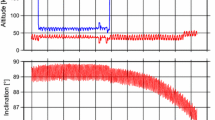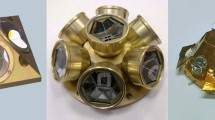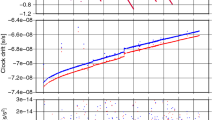Abstract
The lunar orbiter laser altimeter (LOLA) onboard the lunar reconnaissance orbiter has performed high-precision, full-coverage, and high-density laser ranging observations for the entire lunar surface since its launch. Statistics have shown that LOLA has collected 6.94 billion effective altimeter data up to June 2022. Most of the typical orbits in the LOLA dataset have a high quality and exhibit horizontal offsets of almost 7 m and radial offsets of almost 0.5 m. However, there is still a category of orbits in the dataset that will cause apparent noise in the constructed DEM, which is attributed to the orbits with large or anomalous errors. We call such orbits as flawed orbits in this paper. The flawed orbits can be identified and screened by the elevation discrepancy at the crossovers of the orbits. The results show that the flawed orbits are caused by significant along-track errors, which also result in the radial error of up to several kilometers. Moreover, most of the flawed orbits are concentrated in several consecutive time intervals. A correction method is then proposed to correct the flawed orbits in the local region. The position of the flawed orbits is reconstructed using the feature points matching of the DEMs before and after they are removed. Some experimental analyzes show that the apparent terrain artifacts have been eliminated and more identifiable terrain details are reappeared. Identifying and correcting these flawed orbits with significant along-track offsets paves the way for improving the quality of the LOLA data and reconstructing the topography of the Moon.

















Similar content being viewed by others
Data availability
The datasets generated and analyzed during the current study are available from the corresponding author on reasonable request.
References
Barker MK, Sun X, Mao D et al (2018) In-flight characterization of the lunar orbiter laser altimeter instrument pointing and far-field pattern. Appl Opt 57(27):7702–7713. https://doi.org/10.1364/AO.57.007702
Barker MK, Mazarico E, Neumann GA et al (2021) Improved LOLA elevation maps for South Pole landing sites: error estimates and their impact on illumination conditions. Planet Space Sci 203:105119. https://doi.org/10.1016/j.pss.2020.105119
Bertone S, Mazarico E, Barker MK et al (2021) Deriving Mercury geodetic parameters with altimeter crossover from the mercury laser altimeter (MLA). Journal of Geophys Res Planets 126(4):e2020JE006683. https://doi.org/10.1029/2020JE006683
Gläser P, Haase I, Oberst J et al (2013) Co-registration of laser altimeter tracks with digital terrain models and applications in planetary science. Planet Space Sci 89:111–117. https://doi.org/10.1016/j.pss.2013.09.012
Goossens S, Matsumoto K, Rowlands DD et al (2011) Orbit determination of the SELENE satellites using multi-satellite data types and evaluation of SELENE gravity field models. J Geod 85(8):487–504. https://doi.org/10.1007/s00190-011-0446-2
Hao W, Zhu C, Li F et al (2019) Illumination and communication conditions at the Mons Rümker region based on the improved lunar orbiter laser altimeter data. Planet Space Sci 168:73–82. https://doi.org/10.1016/j.pss.2019.01.010
Hu W, Di K, Liu Z et al (2013) A new lunar global DEM derived from Chang’E-1 Laser Altimeter data based on crossover adjustment with local topographic constraint. Planet Space Sci 87:173–182. https://doi.org/10.1016/j.pss.2013.08.004
Lemoine FG, Goossens S, Sabaka TJ et al (2014) GRGM900C: a degree 900 lunar gravity model from GRAIL primary and extended mission data. Geophys Res Lett 41(10):3382–3389. https://doi.org/10.1002/2014GL060027
Li F, Zhu C, Hao W et al (2018) An improved digital elevation model of the lunar Mons Rümker Region based on multisource altimeter data. Remote Sens 10(9):1442. https://doi.org/10.3390/rs10091442
Löcher A, Kusche J (2018) Precise orbits of the lunar reconnaissance orbiter from radiometric tracking data. J Geod 92(9):989–1001. https://doi.org/10.1007/s00190-018-1124-4
Mazarico E, Rowlands DD, Neumann GA et al (2012) Orbit determination of the Lunar reconnaissance orbiter. J Geod 86(3):193–207. https://doi.org/10.1007/s00190-011-0509-4
Mazarico E, Barker MK, Neumann GA et al (2014) Detection of the lunar body tide by the lunar orbiter laser altimeter. Geophys Res Lett 41(7):2282–2288. https://doi.org/10.1002/2013GL059085
Mazarico E, Neumann GA, Barker MK et al (2018) Orbit determination of the lunar reconnaissance orbiter: status after seven years. Planet Space Sci 162:2–19. https://doi.org/10.1016/j.pss.2017.10.004
Neumann GA, Smith DE, Scott SR et al (2016) Lunar reconnaissance orbiter lunar orbiter laser altimeter reduced data record and derived products software interface specification Version 2.6. https://pds-geosciences.wustl.edu/lro/lro-l-lola-3-rdr-v1/lrolol_1xxx/document/rdrsis.pdf
Riris H, Cavanaugh JF, Sun X et al (2009) The lunar orbiter laser altimeter (LOLA) on NASA’s lunar reconnaissance orbiter (LRO) mission. In: Conference on lasers and electro-optics 2009:CFJ1. https://doi.org/10.1364/CLEO.2009.CFJ1
Rowlands DD, Pavlis DE, Lemoine FG et al (1999) The use of laser altimetry in the orbit and attitude determination of Mars global surveyor. Geophys Res Lett 26(9):1191–1194. https://doi.org/10.1029/1999GL900223
Smith WHF, Wessel P (1990) Gridding with continuous curvature splines in tension. Geophysics 55:293–305. https://doi.org/10.1190/1.1442837
Smith DE, Zuber MT, Jackson GB et al (2010) The lunar orbiter laser altimeter investigation on the lunar reconnaissance orbiter mission. Space Sci Rev 150(1–4):209–241. https://doi.org/10.1007/s11214-009-9512-y
Smith DE, Zuber MT, Neumann GA et al (2017) Summary of the results from the lunar orbiter laser altimeter after seven years in lunar orbit. Icarus 283:70–91. https://doi.org/10.1016/j.icarus.2016.06.006
Wessel P (1989) XOVER: a cross-over error detector for track data. Comput Geosci 15(3):333–346. https://doi.org/10.1016/0098-3004(89)90044-7
Wessel P (2010) Tools for analyzing intersecting orbits: the x2sys package. Comput Geosci 36:348–354. https://doi.org/10.1016/j.cageo.2009.05.009
Wessel P, Smith WHF, Scharroo R et al (2013) Generic mapping tools: improved version released. EOS Trans Am Geophys Union 94:409–410. https://doi.org/10.1002/2013EO450001
Xie H, Liu X, Xu Y et al (2022) Using laser altimetry to finely map the permanently shadowed regions of the lunar South Pole using an iterative self-constrained adjustment strategy. IEEE J Sel Topics Appl Earth Obs Remote Sens. https://doi.org/10.1109/JSTARS.2022.3204765
Yue H, Song L, Shizhe Y, Zhiyu Z, Hui Z (2020) Laser pointing error estimation based on energy data of LOLA system. Acta Opt Sin 40(05):188–196. https://doi.org/10.3788/AOS202040.0528001
Zuber MT, Garrick-Bethell I (2005) What do we need to know to land on the Moon again? Science 310:983–985. https://doi.org/10.1126/science.1115126
Acknowledgements
The authors would like to thank NASA for releasing the LRO RDR data used in this study. The data are available at the Planetary Data System Geosciences Node (http://imbrium.mit.edu/DATA/LOLA_RDR). This study was supported by the National Natural Science Foundation of China (42030110, 41874010).
Funding
National Natural Science Foundation of China, 42030110, Weifeng Hao, 41874010, Weifeng Hao.
Author information
Authors and Affiliations
Contributions
All authors read and approved the final manuscript. WH and YZ designed research, processed data, and wrote the paper draft; MY, WZ, YC, JB, and FL revised the manuscript.
Corresponding author
Ethics declarations
Conflict of interest
The authors declare that they have no conflict of interest.
Rights and permissions
Springer Nature or its licensor (e.g. a society or other partner) holds exclusive rights to this article under a publishing agreement with the author(s) or other rightsholder(s); author self-archiving of the accepted manuscript version of this article is solely governed by the terms of such publishing agreement and applicable law.
About this article
Cite this article
Zheng, Y., Hao, W., Ye, M. et al. Correcting flawed orbits with significant along-track offset in LOLA data to remove apparent noise in DEM. J Geod 98, 20 (2024). https://doi.org/10.1007/s00190-024-01827-4
Received:
Accepted:
Published:
DOI: https://doi.org/10.1007/s00190-024-01827-4




